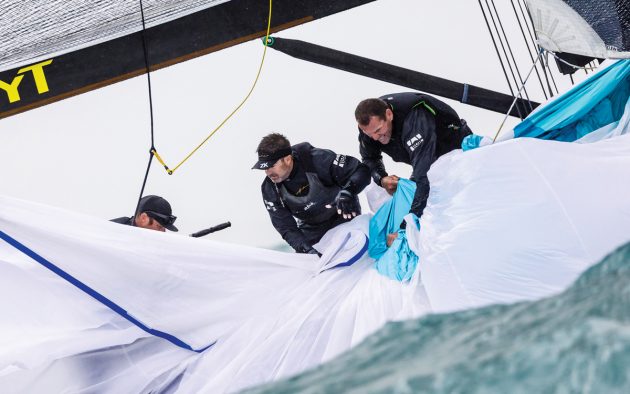Andy Rice talks to former Olympian, keelboat racer and champion race tactician Adrian Stead about retrieving a dropped spinnaker
There are few things quite so humiliating as being stopped dead in the water, moments away from causing thousands of pounds worth of damage as your competitors glide gracefully past.
Veteran pro racer Adrian Stead has found himself in just this scenario more than enough times in his illustrious career but, as he explains, there are ways and means of making the best of a bad situation.
1. Keep clear of the foils
Whenever your spinnaker drops into the water, rule one is to keep it away from the keel and rudder. If you’re on a boat with an asymmetric and the sail is in the water to leeward, your first priority is hold on to the tack line, trying to keep the tack of the sail forward so it doesn’t end up behind the boat.
If you can gybe, the gybe can save the spinnaker because you’re effectively doing a Kiwi drop. You’re rotating the boat around the kite, which also keeps the kite away from the rudder. If the sail does get on the rudder your race is toast, the sail is toast.
If there’s no chance of retrieving it. Unknot the halyard, unknot everything, and then let the sail go. Get someone in a RIB to go and collect it for you. The very last resort is to send someone over to cut the sail free, but you really want to avoid that at all costs.
2. Slow the boat down
If a sail drops in the water, the best thing the helmsman can do is slow the boat down, ideally to a dead stop. The faster you go the more the chance the kite will get away from you. The slower you can go, the more chance your crew can retrieve it because it’s not being pulled out of your hand by the water pressure.
Every knot of boatspeed is squared for water drag. Trying to pull something in at 4 knots is infinitely easier than trying to pull something in at 8 knots.
3. Grab one corner
Wherever possible, grab the sail from one corner. So long as you’ve got a corner, you can probably get the sail back into the boat. If you can’t get a corner, there’s a risk of the sail ballooning in the water and basically turning into a giant drogue – at which point you’re into a wrestling match with tons of water.
4. All hands on
Whenever the sail drops to the water, try to hold on to one of the corners. If you can rehoist it to keep out of the water, then great. But if you can’t and you’re dealing with a potential trawl, you need all the hands you can get on the job. Any crew whose jobs aren’t absolutely critical at that moment should run forwards and help out.
And make sure the sail is fully away and below decks before you turn upwind. I’ve been in a race where we rounded the leeward mark and as soon as we got on the wind, the breeze caught just the head of the spinnaker and next thing we knew, the whole of the sail was out behind us in the water. Disaster! And one that could easily have been avoided.
Bear in mind that even in medium airs, the apparent wind can go from, say, 6 knots across the deck going downwind to 20 knots as soon as you turn upwind. So it’s easy to see how things can go bad if that sail isn’t fully tucked away.
Article continues below…
5 tips: how to deal with snagging weed and hooking pots on an offshore race
The sails look great and you’ve just spent money on having the keel faired and the bottom sprayed, but today…
5 tips: How to prepare your boat for offshore racing
Every serious offshore sailor has more than one story to tell about when it all went spectacularly wrong. Sam Goodchild…
5. Make your plans
Run through your ‘what if?’ scenarios before they happen. Who does what and in what order? It’s better to have run through these scenarios on shore, much harder to make this stuff up in the heat of the moment. This includes planning for the unplanned drop.
For example, if the spinnaker rips or blows out altogether, the key thing is to pull in whatever bits you can as quickly as possible. If the head of the sail is still hoisted on the halyard you may have to send someone up the rig to get the last bits down.
The unplanned kite trawls – the ones that occur through breakage – are probably the trickiest, as you’ve got to try and wrestle down whatever you’ve got left.
If there’s any silver lining it’s that it’s probably easier to retrieve a few bits of rag rather than fight to retrieve one big one. And with the sail already in pieces there’s less worry about trying to preserve kit. That moment has already passed. Tidy up and move on!
 About the expert
About the expert
Adrian ‘Ado’ Stead has twice represented Great Britain at the Olympic Games, sailed in the Volvo Ocean Race, called tactics in the America’s Cup and won numerous keelboat titles in classes like the TP52, Fast 40 and Farr 40. He is tactician for the current RC44 champions, Team Ceeref.






